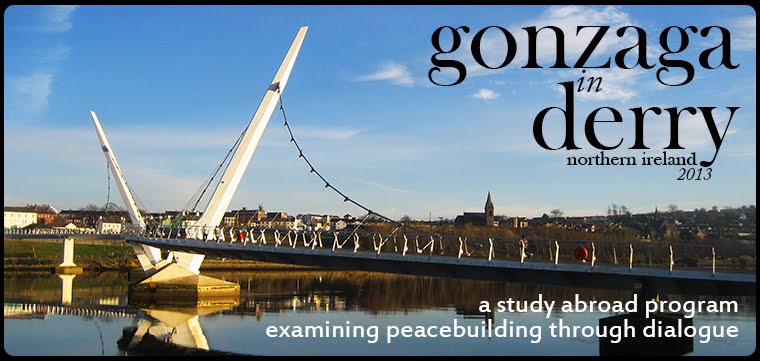Last night a few of us attended a conference featuring the High Kings - a group of four talented men (obviously). The music lifted the spirits of many. The audience didn’t sit idly listening to the performance; instead they were actively participating - clapping, and singing. I listened for a sign of ‘what side they were on’ because it seems that question lingers in the air everywhere we go.
Today we participated in a guided tour around the walls of Derry. Eamon shared stories from the heart and we learned that many of his questions remain unanswered. He is sad about the troubles and is committed to peace. Peace is an ongoing process. Here in Northern Ireland it might make more sense to see PEACE as a verb instead of a noun.
Murals, Eamon explained, are not intended to be ‘in your face’ about what happened. The murals chronicle the history and serve as a reminder of what was and what must be avoided.
It’s a dark part of history but people need to remember. Professor Ann quoted this important revelation. “In the peace building process SILENCE is the enemy.” The process of storytelling and dialogue help move people towards understanding and healing. In the booklets on “Towards Understanding and Healing” (2008), the authors note “The implications for storytelling and dialogue’s impact on society is immense – once people have re-humanized each other after long-term, protracted conflict, it is difficult to return to violence in the future and enables people to work towards a shared society.” (p. 4).
Former combatants Charlie and James were proof of the statement, “…when individuals get a chance to meet ‘the other’ and see the real human being, a miracle happens. Healing comes from both.”
Charlie and James demonstrated mutual respect and listened intently while the other relayed their story of personal grief and loss. They agreed that while it is difficult to understand, both were victims of circumstance. The pain and suffering was mutual and both men are equally committed to peace keeping. Charlie explained that a new community restorative justice system is in place to help deflate troubles before they escalate out of control. For example, if a child of twelve-years is caught throwing stones at a police car, the policeman will not retaliate by using violence directly at the youth. Such situations will be reported back to the parents, resulting in a direct conversation with the youth. The tone is different because it is one of concern for the youth, and a shared responsibility to guide the youth is the next step. This process builds community – a shared community approach.
There are still signs of troubles but everyone remembers the all too recent history of violence and each person we have encountered confirms that shared commitment to peace.
Marion and Mary spoke about their memories of the troubles. They didn’t go out after dark because it was too dangerous. According to these lovely ladies Derry wasn’t as scary as Belfast, but it was a struggle. The troubles made life difficult and unpredictable. Today, they fear for young people who are struggling to find employment. They worry that there are some who turn to gang-like behaviours because they are troubled youth. Back in the days of the IRA, people were fighting for civil rights. Today, young people have romanticized the fight. This can be dangerous because they don’t understand the implications of their actions. Still, they believe in peace and are proud of the community peace relations programs.











No comments:
Post a Comment
Note: Only a member of this blog may post a comment.